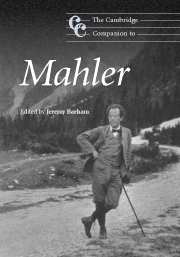Book contents
- Frontmatter
- Introduction: Marginalia on Mahler today
- PART ONE Cultural contexts
- PART TWO Mahler the creative musician
- PART THREE Mahler the re-creative musician
- PART FOUR Reception and performance
- 12 Issues in Mahler reception: historicism and misreadings after 1960
- 13 The history of the International Gustav Mahler Society in Vienna and the Complete Critical Edition
- 14 Musical languages of love and death: Mahler's compositional legacy
- 15 Mahler conducted and recorded: from the concert hall to DVD
- 16 New research paths in criticism, analysis and interpretation
- Appendix: selected discography
- Notes
- Bibliography
- Index
14 - Musical languages of love and death: Mahler's compositional legacy
from PART FOUR - Reception and performance
Published online by Cambridge University Press: 28 September 2011
- Frontmatter
- Introduction: Marginalia on Mahler today
- PART ONE Cultural contexts
- PART TWO Mahler the creative musician
- PART THREE Mahler the re-creative musician
- PART FOUR Reception and performance
- 12 Issues in Mahler reception: historicism and misreadings after 1960
- 13 The history of the International Gustav Mahler Society in Vienna and the Complete Critical Edition
- 14 Musical languages of love and death: Mahler's compositional legacy
- 15 Mahler conducted and recorded: from the concert hall to DVD
- 16 New research paths in criticism, analysis and interpretation
- Appendix: selected discography
- Notes
- Bibliography
- Index
Summary
Introduction
Mahler's posthumous image is resolutely ambiguous. Appropriated as ‘emblematic artist of modernity’ or revered as a ‘prophet of modernism’ he has also, by contrast, been viewed as a ‘model of the postmodern’, and thus ‘emblematic of the emancipation from modernism’. To others he is a relic of a romantic aesthetic, to be eschewed or disavowed. Adorno was an outspoken advocate of the need for progressive, advanced material, but his Mahler writings suggest an alternative, coexistent modernist practice in which manifold layers of meaning and structure are created by the combination of esoteric, immanent configurations with exoteric objects that invite intertextual associations. For Donald Mitchell, similarly to Adorno, Mahler's ‘radical modernity’ is located in the ‘multilayered, multidimensional character of the symphonies’. Against charges of Mahler's tendency to nostalgia, Mitchell argues that ‘the great debate with the past was built into the very fabric of Mahler's symphonies and forms an inescapable part of his modernity’. This complex relationship with cultural precedents is strikingly characterized in Adorno's image of Mahler's music as ghostly reveille in which shadowy, old materials reawake into new life and meaning. The range cast by Mahler's own shadow over the century which followed him is vast.3 I will consider four areas: musical developments in Vienna, songs and operas of love and the night, aspects of symphonic syntax, and compositional reactions to his last completed work, the Ninth Symphony.
- Type
- Chapter
- Information
- The Cambridge Companion to Mahler , pp. 226 - 242Publisher: Cambridge University PressPrint publication year: 2007



